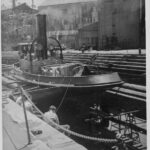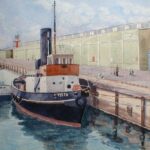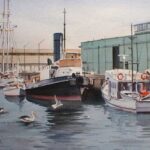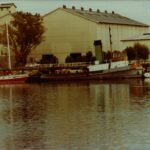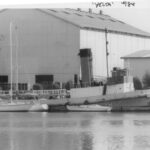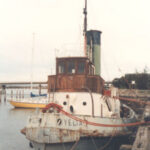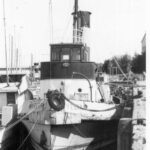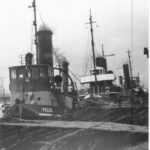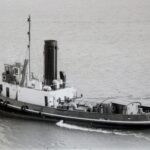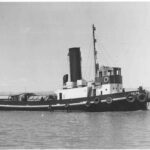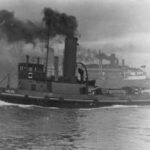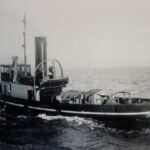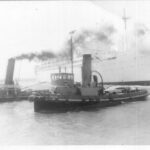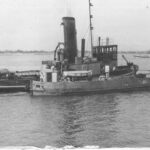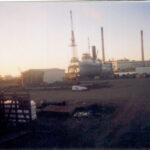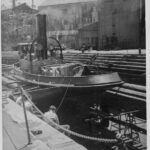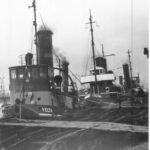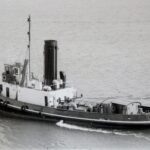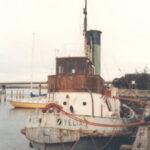The steam tug Yelta was built in Sydney between 1948 and 1949 and commissioned for service in Port Adelaide, where it remained for the duration of an active, newsworthy career. Retired in 1976, the vessel was left virtually derelict on the Port’s waterfront for nearly a decade. It was subsequently purchased by the South Australian Maritime Museum and—with the able assistance of a group of enthusiastic and knowledgeable volunteers—restored and refitted for use as a floating museum. Yelta currently embarks passengers for historic cruises of the Port River several times a year, and serves as a tangible reminder of the Port’s former fleet of working watercraft.
Origins
Yelta’s keel was laid at Sydney’s Cockatoo Island Dockyard in 1948. The Cockatoo Docks and Engineering Company built the vessel on contract to Port Adelaide-based firm Ritch and Smith, Ltd. As completed, the tug had an overall length of 103 feet, 3 inches (31.5 metres), breadth of 26 feet, 8 inches (8.13 metres), and a 13-foot (3.94-metre) draught. With the exception of welded plate butts (the interfaces where the ends of hull plates butted against one another), the entire hull was of riveted plate construction and covered by cement render in several areas. Yelta’s main deck was formed of steel plating, which was sheathed in timber in the forward and aft accommodation areas.
The vessel was powered by a triple-expansion reciprocating steam engine capable of delivering 970 indicated horsepower to a four-bladed cast iron propeller that measured 8 feet (2.44 metres) in diameter. Steam was generated by a 16-foot (4.9-metre) diameter boiler capable of holding 18 tons of water and producing 200 pounds-per-square-inch (1400 kilopascals) of pressure. Eighteen hours were required for the boiler to generate enough pressure to get underway. Yelta’s engine was originally fuelled by coal, but was converted to burn heavy oil in 1957.
Six crewmen, comprising a captain, engineer, fireman, greaser and two deckhands, were required to operate the tug. Accommodation was segregated between the officers (captain and engineer) and crew (fireman, greaser and deckhands). The officers’ cabins were located in the forward part of the vessel and bunks and general living quarters for the crew were positioned aft. A galley featuring basic kitchen amenities—such as a stove and sink—was located on the main deck immediately forward of the boiler, and a saloon was situated below decks immediately adjacent to the officers’ accommodation.
Career
Yelta arrived at Port Adelaide on 22 February 1949 and joined the Port’s existing fleet of five tugs shortly thereafter. With one exception (the tug Foremost, built 1926) all of these vessels were over 30 years old. Included among their ranks were Chesterford (1911), George Dinsdale (1913) and Woonda (1915). Incredibly, the tug Falcon was also still in use, despite having operated in the Port since 1884!
For the next 27 years, Yelta guided numerous ships in and out of the Port River, and assisted in freeing others that had run aground in and around its entrance. In 1950 the tug helped extract the freighter Eastwave from a shoal near the North Arm. Two years later, it did the same for the tanker Caltex Bombay in nearly the exact same location. Yelta’s physical appearance changed in conjunction with two separate episodes of structural alteration during the 1960s. The first, in 1964, reduced the size of the cabin and included the addition of doorways on both the port and starboard sides of the wheelhouse. In 1967, the entrance to the crew accommodation in the aft portion of the vessel was changed from a simple hatch to a deckhouse. Yelta’s paint scheme appears to have changed very little for the duration of its service life. The entirety of the hull above the waterline was painted black save for a series of white deck structures and the decks, which were painted red or green.
Retirement, Restoration and Exhibition
In November 1976, Yelta was retired from service and laid-up. Shortly thereafter, it was purchased by the Port Adelaide branch of the National Trust of South Australia as a maritime heritage asset. However, any restoration efforts that may have been in the works failed to materialise and the vessel was moved to the CSR Refinery’s ‘Sugar Wharf’, where it remained virtually abandoned for a decade. Recognising Yelta’s historical significance as Port Adelaide’s last surviving steam tug, the South Australian Maritime Museum (SAMM) purchased the vessel in May 1985 and added it to the museum’s heritage fleet.
SAMM’s first order of business was to restore Yelta to working order so it could operate as both a floating museum and functional passenger vessel. To accomplish this goal, SAMM’s Chief Engineer/Fleet Manager recruited a corps of retired and semi-retired volunteers with lengthy and comprehensive experience in various maritime industries. The group, known as the ‘Yelta Engineers’, transformed the tug from a hopeless derelict to working steam vessel within a span of three years. Their efforts included extensive repair of waterline hull plates, which had corroded to such an extent that large openings appeared in their steel fabric during grit-blasting to remove pre-existing layers of paint and marine fouling. Work was also undertaken to update the vessel so that it met modern safety standards required of a passenger vessel under the Uniform Shipping Laws Code. Following completion of the restoration and upgrade, Yelta was (re)launched to great fanfare on 5 October 1988.
Since its integration within SAMM’s heritage fleet, Yelta has conducted countless cruises of the Port River, and served as an effective means of sharing and promoting the history of Port Adelaide and its maritime industry and infrastructure. It is the only working steam tug in South Australia, and its fabric is representative of a vessel type once integral to the Port’s operation. Yelta also serves as a tangible reminder of—and testament to—those who served (and occasionally lived) aboard it.


